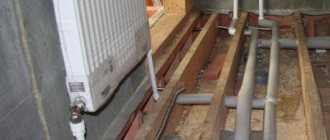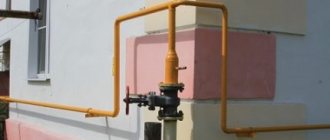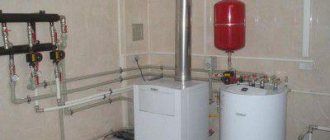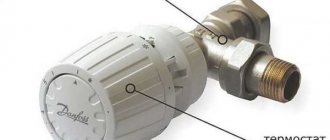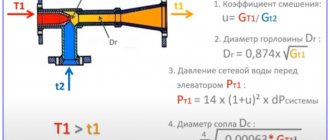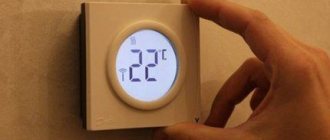One of the important steps towards saving budget funds on heating is organizing heat energy metering. Accounting for resources such as gas, water and electricity has long been commonplace for most consumers. At the same time, the majority thought that it was impossible to bring heat under this line, so installing heating meters in the apartment became a kind of innovation for them. How to properly install a heat meter? Let's figure it out.
Which one to install: individual or communal?
There can be two options for installing a meter: a general house heat meter or an individual heat meter for an apartment. And each option has its own advantages and disadvantages.
Option No. 1 – communal heat meter. For residents of an apartment building, heat metering can be done by installing a common building heat meter for heating in the apartment building. By the way, this solution is the cheapest. After all, the cost of the meter itself, which is very decent, and the price of its installation will be divided among the owners of high-rise apartments. As a result, the amount you have to pay will not be so high.
Data from the meter is taken monthly. And the received amount is distributed between apartments according to its area. Also, if the service provider does not comply with the temperature specified in the contract, then according to the law he is obliged to return the money paid to the residents. But before installing a meter of this type, it is worth observing some nuances.
First, you need to hold a house-wide meeting and interview everyone who wants to install a heat meter. It is necessary to discuss the specifics of the subsequent installation of a heat meter, as well as to choose who will take meter readings and issue receipts for payment of thermal energy. The result of the meeting must be recorded in the minutes, after which a written statement can be sent to the management company about the residents’ desire to install a heat meter.
From the installation side, the most economical are general house heat meters for heating. But there are a number of points that reduce its effectiveness in saving budget funds in the future. For example, heat loss may occur due to poorly insulated entrances or apartments of other residents, and you will have to pay more for heat.
Option No. 2 – individual metering devices. Undoubtedly, installing a common house heat meter is cheaper, but in the future you should not expect any special economic effect from it. For this reason, many consumers choose individual heat meters, which are installed directly in the apartment. Installation of such a device is much more expensive, but the results from its use are much higher. You will pay less for heat than using a common house meter!
It is important to understand how a heating meter works: a distributor is mounted on each radiator in the apartment. Their task is to record temperature and its changes throughout the month. Based on these data, payment for thermal energy is calculated.
But before you begin any preparatory activities for installing a meter, you need to familiarize yourself with some technical limitations. The heat meter is installed on a riser that leads to the apartment. Old apartment buildings are often equipped with vertical pipe distribution. It follows from this that an apartment may have several risers, each of which needs to be equipped with a heat meter, which takes a significant toll on the budget. A way out of this situation may be to install special meters on heating radiators.
Manufacturers of heat meters recommend installing so-called distributors in houses with vertical wiring, the task of which is to measure coolant flow, based on the temperature difference, on the surface of the radiator and in the air of the room.
In buildings with horizontal wiring, installation of any heat meters is not complicated at all. Compact devices are installed on a pipe that supplies coolant to the living space. Sometimes it happens that heat meters are installed on the return pipeline; they have a different operating principle.
Is it profitable to install a meter in an apartment?
It is beneficial to install a heating meter in your apartment. The home owner spends money only for the heat provided by the heating radiators, without paying for losses during its transportation. In order to save as much as possible, you need to get rid of any possible sources of heat loss as much as possible: insulate the room, install sealed window frames, etc.
Heat meter, self-adjusting
At the request of VitЁk, in the topic HEATING, I am writing instructions on how to independently adjust the coolant flow, which in turn affects the heat consumed by your home/entrance.
ATTENTION! THE AUTHOR DOES NOT TAKE ANY RESPONSIBILITY, YOU PERFORM ALL ACTIONS AT YOUR OWN RISK!
So, let's start with the formula for calculating thermal energy, it looks like this: Q = V * ( T1 – T2 ) / 1000 and is measured in gigacalories (gcal). Explanation: Q - thermal energy V - volume of coolant (water) T1 - supply temperature (water that enters the house) T2 - return temperature (water that leaves the house)
Having studied the formula, we can conclude that we can achieve a minimum consumption of gcal (for which we pay) by reducing either the volume of water or the temperature delta. Reducing the temperature delta is possible due to insulation of pipes and manipulations with sensors (which entails a fine, so we will not consider this), but the sensors themselves are usually sealed, although I don’t have to. It remains to reduce the volume of water, which is exactly what we can do. To do this, consider the diagram below.
What a heat meter looks like:
Meter display with readings:
On the display, we can notice that the meter also shows us such parameters as: W - heat load (how much heat an object consumes per hour), in my case the meter shows it in megawatts, 1 MW = 0.861 Gcal. G - coolant flow (how much water passes through the heating system of the facility per hour)
In this diagram we are interested in two ball valves, with their help we can adjust the coolant flow, but it is more correct to do this using a valve in front of the meter, which looks like this: If you have one, then it is better not to touch the valves and only turn it . In my house, for example, there is no valve, so the flow can only be adjusted using these taps (you can also install a special washer to reduce the diameter of the pipe, but for this you need to remove the meter and in this case the possibility of adjustment is lost).
Well, we actually begin to turn the taps or valves and monitor the heat load parameter; it is necessary to set the flow rate at which this value is minimal in order to achieve maximum savings.
PS I learned about all this from the employees of the heating network, who arrived, explained everything and said - screw it, we don’t have time (the readings on the display of my meter are updated every 5 minutes), they said that according to the standards it is necessary to set the flow rate to 1.2, but with this with a flow rate I had a thermal load of 0.012-0.013, and with a flow rate of 1.6 it became 0.009-0.010. Thus, I achieved savings of 5 UAH per square meter, compared to the twin neighboring house, in which the consumption was set to 1.2 according to the “norms”
At the request of VitЁk, in the topic HEATING, I am writing instructions on how to independently adjust the coolant flow, which in turn affects the heat consumed by your home/entrance.
ATTENTION! THE AUTHOR DOES NOT TAKE ANY RESPONSIBILITY, YOU PERFORM ALL ACTIONS AT YOUR OWN RISK!
So, let's start with the formula for calculating thermal energy, it looks like this: Q = V * ( T1 – T2 ) / 1000 and is measured in gigacalories (gcal). Explanation: Q - thermal energy V - volume of coolant (water) T1 - supply temperature (water that enters the house) T2 - return temperature (water that leaves the house)
Having studied the formula, we can conclude that we can achieve a minimum consumption of gcal (for which we pay) by reducing either the volume of water or the temperature delta. Reducing the temperature delta is possible due to insulation of pipes and manipulations with sensors (which entails a fine, so we will not consider this), but the sensors themselves are usually sealed, although I don’t have to. It remains to reduce the volume of water, which is exactly what we can do. To do this, consider the diagram below.
What a heat meter looks like:
Meter display with readings:
On the display, we can notice that the meter also shows us such parameters as: W - heat load (how much heat an object consumes per hour), in my case the meter shows it in megawatts, 1 MW = 0.861 Gcal. G - coolant flow (how much water passes through the heating system of the facility per hour)
What are thermostats?
An automatic thermostat is a system for controlling the heating level of radiators. Regulators are installed on the heating system pipes in front of each radiator in order to maintain a certain temperature in the rooms. Thermostats automatically turn radiators on or off. If heat meters are available, this system helps to save on heat consumption.
Thermostats can be installed in any apartment, regardless of the heating system: central, house or apartment.
True, with an apartment-by-apartment system, owners can adjust the temperature in the apartment using an individual boiler. Therefore, thermostats are needed only if they want to maintain different temperatures in the rooms, for example, in the living room +19, and in the nursery +21 degrees.
Automatic thermostats should be installed together with batteries. If you do this after installing the radiators, you will have to shut off the water in the heating system. It is convenient if there are ball valves on the radiators, which disconnect the radiators from the heating system without disturbing the neighbors. If there are no ball valves, you will have to shut off the entire riser.
No savings on the heat meter
Why are there no savings on the heat meter?
Photo: iraukr Sochi 2014, April
Having installed a heat metering unit, you may encounter the problem of a lack of savings, or the heat meter results in the same as without it. The metering unit does not meet your expectations and costs.
Some people, having spent money on an accounting unit, remove it from commercial accounting, others carry out a set of measures, and only then enter it into commercial accounting.
The first reason I want to dwell on is the unregulated thermal-hydraulic mode.
The metering unit itself does not save heat energy, but only shows the FACT of its consumption. The metering unit will not effectively justify itself without control devices. Without these devices, the node is incomplete. By “pressing up” the coolant you reduce Gcal consumption. You need to stay within the temperature schedule as much as possible.
A temperature schedule must be attached to the heat supply contract. This graph reflects what temperature the coolant should be in the supply and return pipelines, or the DHW network at the border of the balance sheet (BP) of the heating networks between the consumer and the heat supply company, i.e. what should be the temperature difference? These temperatures depend on the weather, on the outside air temperature, all of this is reflected in the graph.
The heat supply company must withstand the proper temperature in the supply pipeline and the DHW network at the border of the power supply unit, and the proper temperature in the return pipeline must be maintained by the Consumer.
In addition, this affects not only savings, but can also lead to penalties, regulations and measures on the part of the heat supply organization.
This is what our inspectors write in their violation reports:
“It is necessary to adjust the thermal-hydraulic mode of the heating system by installing a throttle diaphragm.
After eliminating the violations, call a representative of the heat supply company to examine the parameters of the coolant.
In case of non-compliance with the instructions, the calculation of the consumed thermal energy will be made based on the temperature difference corresponding to the temperature schedule.”
I will describe possible technical problems using examples from real life, this is of course rare, but in case it comes in handy for someone.
Having refused the services of a management company and taken matters into our own hands, our HOA during the first heating season was faced with the problem of saving thermal energy.
There were savings, but they were very small; in previous years, Gcal consumption was less, and without metering devices it was even more expensive. According to the printouts from the accounting center, everything was beautiful. Our actions did not give the desired result, either there were savings, but the residents froze, or vice versa. People were unhappy, they called specialists from a specialized organization, but there was no effect.
There would be no happiness, but misfortune would help. At night the pressure gauge broke, after the accident was eliminated, we began to wonder how much the accident would cost us. The device showed that one amount of coolant came in, but came out to 30 cubic meters. more, although it should be the other way around.
It turned out our flow meters were connected incorrectly
Having switched the flow meters, the heat meter began to show that more coolant was coming out than coming in, but within the permissible error. And bills for payment decreased by 35%.
Another case.
A heat metering unit was installed at the enterprise. After installing special software, the energy engineer incorrectly configured the data output template. The testimony was submitted to the heat supply company signed and stamped by the director. The invoice was several times higher than in previous months. After long negotiations with the thermal energy supplier, it was possible to reduce only part of the presented amount.
Conclusion: you need to be well versed in the numbers in the reports and see how real they are. Analyze your Gcal consumption with previous years (months) at the same outdoor temperature.
The next possible reason is high actual heat consumption.
It’s like with water meters in apartments, some have savings, but others don’t. And because Gcal are distributed using the balance method, then, perhaps, previously your heat consumption was paid for by someone else. Now this someone will be a little easier financially.
What is the best way to install a heat meter?
The simplest solution would be to install an overhead device, since it does not require hiring an appropriate specialist and cutting pipes. It will be enough to attach the heat meter to the battery. The situation is different with mechanical devices; to install these devices, you need to shut off the risers, drain the water and dismantle part of the pipe. The same situation applies to ultrasonic devices that cut directly into the pipeline.
As mentioned earlier, before delivering this equipment, you must have a permit and a ready-made project. And in order to avoid problems with commissioning and payment for the device by the supplier, its installation must be carried out by a licensed company, which will be indicated in the work completion certificate. The specialists of this company carry out work according to the following stages:
- make a connection project;
- coordinate the necessary documentation with the heat supplier;
- install a heat meter;
- register the device;
- put the device into operation, transferring it to the control of the controlling organization.
If you decide to carry out this work yourself, first carefully read the instructions for the heat meter. It contains recommendations for installing the device and its operation, which must be strictly followed. By the way, ultrasonic and mechanical devices must be provided with a measuring section of a certain size. That is, a straight pipe must be installed before and after the device without turns or bends.
The measuring section for a mechanical heat meter must be at least 3 pipe diameters before the flow meter and one after. Ultrasonic heat meters are more demanding; the measuring section must be at least 5 diameters before and 3 after the device (this data depends on the manufacturer).
Now let's talk about whether it is possible to install an individual heat meter on the return pipeline. Most manufacturers make meters that can be installed on any highway; the main thing is not to mix up the temperature sensors. Usually they are screwed into a tee or a special tap equipped with a separate pipe for this purpose.
In fact, in countries in the post-Soviet space, it is often quite difficult to legally install and commission an individual heat meter. Perhaps the effort and material resources invested in this device will not be worth the result. Therefore, it is recommended that before contacting an individual metering organization, it is better to consult with the heat energy supplier.
Metering devices are quite good helpers for those who want to save their money. Anyone who does not want to pay for losses during heat transportation is recommended to think about installing a heat meter. Moreover, this is not such a difficult task. The main thing is to decide which metering device you want to install, communal or individual; the rest of the work is best left to professionals.
News:
forum for heat supply specialists
Which heating is more profitable - central or apartment heating? Or can you save only with your own boiler room? Roman Sidlauskas, development director of the Russian representative office of the Italian radiator manufacturer Global Radiatori, talks about how to save on heating at all levels.
Advantages of devices
In addition to the fact that installing individual heat meters in an apartment allows you to make payments depending on the readings, it undoubtedly has other advantages.

Heat meters for apartments
These characteristic advantages include:
- Private meter installations in a residential area allow you to regulate energy consumption depending on weather conditions. This is mainly in demand during the spring and autumn periods, when the temperature outside can change every day.
- Using the device, you can detect malfunctions in the coolant line (air pockets, blockages). This leads to an uneven supply of heat, which, of course, will immediately appear on the meter readings in the apartment.
- The installation of individual heat meters is also necessary because utility organizations calculate heating fees according to established standards, and not based on actual consumption. With the device, every month the heat in the apartment will be metered according to the readings.
Thus, the benefit of installing individual heat energy meters in an apartment is obvious.
On a note. A heat meter installed on hot water supply (DHW) will quickly justify its cost if the heating in the house is of poor quality. This is possible because if the meter readings are below 40˚, the calculation is made as for cold water (according to Government Decree No. 354).
Meanwhile, the installation of such devices has a number of features, and therefore it is necessary to pay special attention to them.
Heat meters in the apartment
Individual products have a small pipe flow area, not exceeding 20 mm, and the calculation occurs in the range from 0.6 to 2.5 m/h. This is allowed based on the coolant flow rate and the different water temperatures in the inlet and outlet pipes of the heating main.
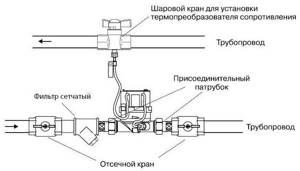
Heat meter connection diagram for apartments
Principle of operation
The operation of the heat meter is based on the principle of calculating the amount of heat using data taken from a coolant flow sensor and a pair of temperature sensors. The amount of water passing through the heating system is measured, as well as the temperature difference at the inlet and outlet.
The amount of heat is calculated by the product of the flow rate of water passing through the heating system and the difference in temperature of the incoming and outgoing coolant, which is expressed by the formula
Q = G * (t1-t2) , gCal/h, in which:
- G – mass flow of water, t/h;
- T1,2 – temperature indicators of water at the inlet and outlet of the system, °C.
All data from the sensors is sent to the computer, which, after processing it, determines the value of heat consumption and records the result in the archive. The value of consumed heat is displayed on the device display and can be taken at any time.
What affects the accuracy of the heat meter
Techem compact V
A heat meter, like any precision device, when measuring consumed heat has a certain total error, which is the sum of the errors of the temperature sensors, flow meter and calculator. In apartment accounting, devices are used that have an acceptable error of 6-10%. The actual error may exceed the basic one, depending on the technical characteristics of the component elements.
The increase in the indicator is determined by the following factors:
- The amplitude of the incoming and outgoing coolant temperatures, which is less than 30°C .
- Violations during installation in accordance with the manufacturer's requirements (if installed by an unlicensed organization, the manufacturer will withdraw its warranty obligations).
- Poor quality of pipes, hard water used in the coolant, and the presence of mechanical impurities in it.
- When the coolant flow rate is below the minimum value indicated in the technical specifications of the device.
How is heat consumed measured?
It is customary to calculate the tariff for consumed heat in gigacalories. The unit of measurement is non-systemic, and has traditionally been used since the existence of the USSR. Devices manufactured in Europe calculate heat consumption in GigaJoules (SI system), or the generally accepted international non-systemic unit kWh (kWh) .
Differences in measurement systems among employees of heat supply organizations do not cause any particular difficulties in how to calculate heating charges, since some units are easily converted to others using a certain coefficient.
Classification and principle of operation of heat meters
The priority principle of operation of all similar products for metering thermal energy is readings at a certain water temperature.
Any heat accrual device consists of three components:
- Sensor;
- Unit for distribution, pressure and fluid resistance;
- Device for metering received thermal energy.
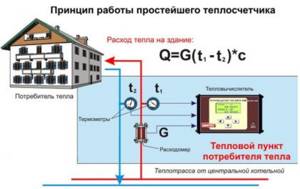
Scheme of the operating principle of a common house heat meter
In addition, meters are divided by purpose. They are available for individual and industrial (household) use.
Devices for houses with autonomous heating and apartments differ from house ones in more precise adjustment.
Heat energy metering devices for home use are divided into several types:
- Mechanical;
- Electromagnetic;
- Ultrasonic;
- Vortex devices.
To better understand their fundamental work, let’s look at each variety in more detail.
Tachometer instruments
The most affordable and understandable from the point of view of the average person are mechanical devices. Such devices use a rotating drum in the form of a small turbine as a meter.
It rotates from the pressure of the coolant, thanks to which water consumption is recorded. Typically, tachometer meters are equipped with two flow meters (on the inlet and outlet pipes), a resistance element and a heat calculator.
Sometimes devices are provided with pressure sensors. Such meters must have filters installed at the entrance. If the equipment is put into operation without them, then the presence of mechanical impurities (particles of sand, gravel, rust) will affect the operation of the device, and it will produce distorted readings.
Electromagnetic devices
This device's operating principle is based on the manifestation of electromagnetic induction. Inside the product there are several magnets that create a field of the same name.
As you know, water is a good conductor and when it passes through a magnetic field, an electric current is generated. Moreover, its value is directly proportional to the speed of fluid flow.
The generated electric current enters the computing node. And since the difference in current values is small, such devices require proper installation and special operating conditions.
Data readings will be distorted if the device is connected in violation of the required level (vertical instead of horizontal heating distribution in a high-rise building). And also at the junction there should not be a narrower throughput channel.
And one more factor that influences the reliability of information for coolants of this type is that the presence of iron in any form (scale, rust) is excluded in the water.
Ultrasonic heat metering
Meters with ultrasonic radiation are characterized by an unusual operating principle and high cost. The originality lies in measuring the passage of a wave through a liquid, depending on the speed of the coolant.
In other words, the flow rate is calculated by the time it takes for the signal to arrive from the radiation source to the receiver. In these products, strict placement of devices on the same line is important.
Vortex heat accounting
Turbulent-type devices are distinguished by a special measurement. In the path of the coolant in the pipeline there is a prism, which is an obstacle, and a vortex flow occurs.
The number of vortex branches is recorded by special sensors and flow meters, which are located at a certain distance from the prism. And the stronger the flow speed, the greater the number of vortices formed.



